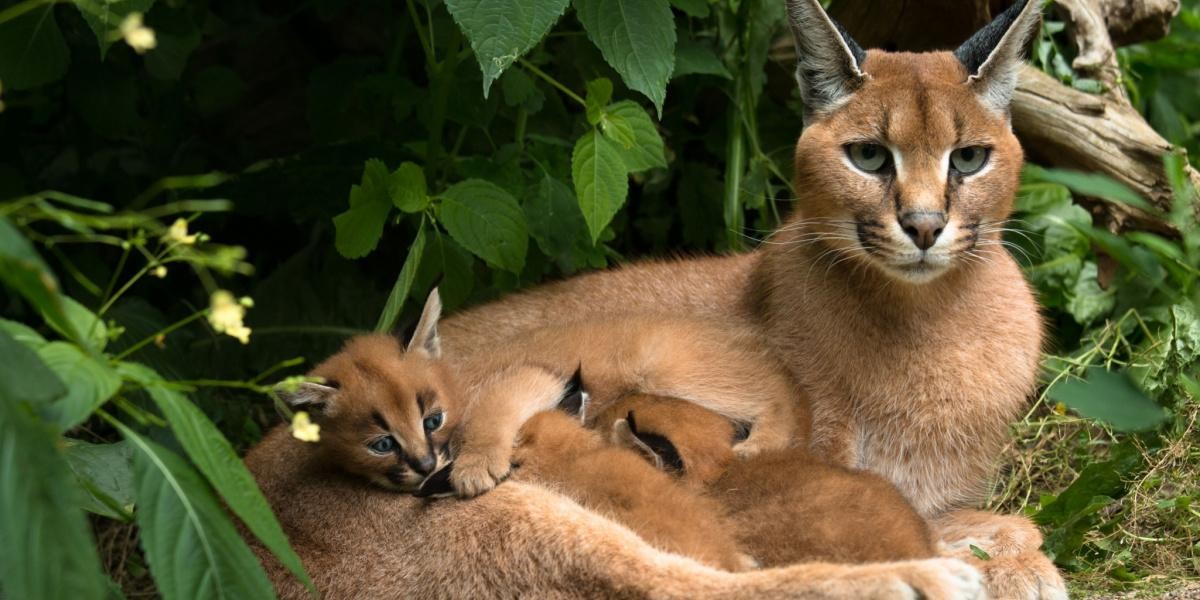Are you wondering, “Can You Have A Pet Floppa?” The answer isn’t straightforward. Floppa, often referring to caracals, are wild cats, and while the idea of owning one might seem appealing, it comes with significant considerations. PETS.EDU.VN is here to guide you through the complexities of caracal ownership, legality, and responsible pet choices, ensuring you make an informed decision that prioritizes the animal’s well-being and your safety. Discover the realities of caring for a wild cat and explore domestic alternatives that offer a similar aesthetic without the inherent challenges.
1. Understanding the Caracal: A Wild Cat
The caracal (Caracal caracal), sometimes called the desert lynx (though not a true lynx), is a wild cat species native to Africa, Central Asia, India, and the Middle East. There are three subspecies:
- Southern caracal (C. c. caracal): Found in South and East Africa.
- Northern caracal (C. c. nubicus): Found in North and West Africa.
- Asiatic caracal (C. c. schmitzi): Found in Central Asia and India.
Caracals are characterized by their long legs, short, tan or sandy-colored coat, and striking large, tufted ears. Adult caracals typically weigh between 20 and 40 pounds, making them significantly larger than most domestic house cats.
2. Exploring the Cat Family: Where Caracals Fit In
All cats, wild and domestic, belong to the Felidae family. This family is further divided into two subfamilies: Pantherinae and Felinae.
2.1. Pantherinae: The Big Cats
This subfamily includes the seven big cat species, classified into the genera Panthera and Neofelis:
- Lion (Panthera leo)
- Tiger (Panthera tigris)
- Jaguar (Panthera onca)
- Leopard (Panthera pardus)
- Snow leopard (Panthera uncia)
- Mainland clouded leopard (Neofelis nebulosa)
- Sunda clouded leopard (Neofelis diardi)
2.2. Felinae: The Smaller Cats (and Domestic Cats)
This subfamily is much larger, containing various wild cat species and our domestic house cats. Some common members include:
- African wildcat (Felis lybica)
- Asian golden cat (Catopuma temminckii)
- Bobcat (Lynx rufus)
- Caracal (Caracal caracal)
- Cheetah (Acinonyx jubatus)
- Cougar or mountain lion (Puma concolor)
- Domestic cat (Felis catus)
- Jungle cat (Felis chaus)
- Leopard cat (Prionailurus bengalensis)
- Ocelot (Leopardus pardalis)
- Serval (Leptailurus serval)
Most Felinae species are smaller than the big cats in Pantherinae. Notably, Pantherinae cats (except the snow leopard) can roar but cannot purr, while Felinae cats can purr but cannot roar due to differences in their hyoid bone structure.
3. Caracals and Domestic Cats: A Distant Relationship
Caracals and domestic cats belong to the same subfamily, Felinae, indicating a degree of relatedness. However, this doesn’t mean caracals can be easily tamed. They remain wild animals, retaining their natural instincts even in captivity.
4. The Reality of Caracals as Pets: Why It’s Discouraged
While owning a caracal might seem exciting, wildlife experts strongly advise against it. Caracals are unpredictable and potentially dangerous, even if bred as pets.
4.1. Wild Instincts and Aggression
Caracals’ wild instincts can be triggered at any time, leading to aggressive behavior toward humans, especially children, and other pets. They possess powerful jaws, sharp teeth, and claws, capable of causing serious harm.
4.2. Territorial Behavior and Messiness
Caracals are territorial and messy. They often require special outdoor enclosures due to their destructive behaviors like scratching, urine spraying, and open defecation.
4.3. Veterinary Care Challenges
Finding a veterinarian willing to treat a caracal can be difficult and expensive. Specialized care from a wild animal veterinarian may require extensive travel.
4.4. Dietary Needs
Caracals have specific dietary needs, requiring a specialized carnivorous diet that may include raw meat, making feeding them difficult and costly. In the wild, their diet consists of birds, rodents, hyraxes, hares, and even small antelopes.
4.5. Animal Welfare
Caracals are happiest in their natural habitat. Unlike domestic cats, they are not suited for cohabitation with humans and cannot fully express their natural instincts in a human environment.
5. Legality of Caracal Ownership
The legality of owning a caracal varies by state. Some states allow it with a special license or permit, while others ban it outright. Even if legal, owning a caracal is not necessarily a wise choice due to the challenges and ethical considerations involved.
6. Cat Breeds That Resemble Wild Cats: A Responsible Alternative
If you are drawn to the exotic look of a caracal but understand the importance of domesticating pets, several cat breeds offer a similar aesthetic without the inherent challenges. These breeds, some of which are hybrids, have been developed to be gentle and friendly companions.
6.1. Pixie-Bob
The Pixie-Bob, despite claims of being a bobcat hybrid, is a domestic breed known for its wild appearance, short tail, and loving, active, and social temperament.
6.2. Chausie
The Chausie, a hybrid breed developed by crossing a jungle cat with domestic cats, resembles the caracal with its sandy, reddish-brown, or gray fur. This breed is active, athletic, and sociable.
6.3. Savannah
The Savannah, a hybrid breed developed using the African serval, has a slender body, small head, and large ears, similar to the serval. Savannahs are curious, outgoing, and assertive, enjoying water play and requiring ample exercise and mental stimulation.
6.4. Bengal
The Bengal, a hybrid breed resulting from crossing domestic cats with the Asian leopard cat, has a beautiful and unique coat pattern, sometimes featuring rosette spots reminiscent of leopards and jaguars. Bengals are energetic, outgoing, curious, and affectionate.
6.5. Serengeti
The Serengeti, though developed to resemble the African serval, contains no serval blood. It was created using Bengals and Oriental Shorthairs. The Serengeti is confident, friendly, active, and talkative.
6.6. Toyger
The Toyger, bred to resemble a miniature tiger, has very little wild cat blood. This breed was created using a domestic cat, a Bengal, and a street cat from India. Toygers are docile, smart, and very friendly.
7. Understanding Search Intent
To provide comprehensive information, it’s essential to address the various search intents related to the query “Can you have a pet Floppa?”:
- Legality: Users want to know if owning a caracal is legal in their area.
- Practicality: Users are curious about the challenges and responsibilities of caracal ownership.
- Cost: Users want to understand the financial implications of owning a caracal.
- Ethical Considerations: Users are interested in the ethical aspects of keeping a wild animal as a pet.
- Alternatives: Users seek information on domestic cat breeds that resemble caracals.
8. Frequently Asked Questions About Caracals as Pets
8.1. Are caracals friendly to humans?
Caracals are wild animals and are not inherently friendly towards humans. They are solitary creatures that prefer to live alone. Even caracals bred as pets retain wild instincts, including an aversion to humans.
8.2. Is a caracal cat aggressive?
Caracals, even those bred to be sold as pets, retain their wild instincts. They can be aggressive towards humans and other animals. While they might learn to live with humans, they remain unpredictable and potentially dangerous.
8.3. Can a caracal hurt you?
While caracal attacks on humans are rare, they can occur, especially when these animals are kept as pets. Caracals are more likely to injure children and the elderly and can harm or kill other pets.
8.4. How much does a caracal cost?
Breeders raise and sell caracals as pets, and they can cost exorbitant amounts. However, wildlife experts strongly advise against keeping caracals as pets, even if it is legal to do so.
8.5. What are the specific dietary needs of a caracal?
Caracals require a specialized carnivorous diet, often including raw meat. This diet can be expensive and challenging to maintain.
8.6. What kind of environment does a caracal need?
Caracals need a large, secure outdoor enclosure that mimics their natural habitat. They require ample space to roam and exhibit natural behaviors like hunting and climbing.
8.7. Are there any specific health concerns for caracals?
Caracals can be susceptible to various health issues, including parasitic infections, respiratory problems, and nutritional deficiencies if their diet is not properly managed. Finding a veterinarian experienced in treating exotic cats is crucial for their healthcare.
8.8. What are the ethical considerations of owning a caracal?
Keeping a caracal as a pet raises ethical concerns about animal welfare, conservation, and public safety. Wild animals belong in their natural habitats, and removing them can disrupt ecosystems and contribute to the exotic pet trade.
8.9. Can caracals be trained?
While caracals can be trained to some extent, their wild instincts make them less amenable to training than domestic cats. Training requires specialized knowledge and experience working with exotic animals.
8.10. What are the alternatives to owning a caracal?
Several domestic cat breeds resemble caracals in appearance but are better suited as pets. These breeds include the Pixie-Bob, Chausie, Savannah, Bengal, Serengeti, and Toyger.
9. The Importance of Ethical Pet Ownership
Choosing a pet is a significant decision that should be based on responsible and ethical considerations. Owning a wild animal like a caracal can have negative impacts on the animal’s well-being, public safety, and conservation efforts.
10. Conclusion: Making an Informed Decision
While the allure of owning a “Floppa” or caracal might be strong, the realities of caring for a wild animal make it an impractical and unethical choice for most people. Consider the challenges, legal implications, and ethical considerations before pursuing caracal ownership. Explore the various domestic cat breeds that offer a similar aesthetic without the inherent challenges.
PETS.EDU.VN encourages responsible pet ownership and provides valuable information on caring for various pets. Remember, a pet is a lifelong commitment, and choosing the right one is crucial for both the animal’s well-being and your own.
For more detailed information on responsible pet ownership, cat breeds, and pet care, visit PETS.EDU.VN. If you have any questions or concerns, please contact us at 789 Paw Lane, Petville, CA 91234, United States, Whatsapp: +1 555-987-6543.
Ready to learn more and find the perfect pet for your lifestyle? Visit PETS.EDU.VN today for expert advice and resources on responsible pet ownership.
Dive deeper into the world of exotic cat breeds and discover fascinating facts about feline behavior and care at pets.edu.vn!

